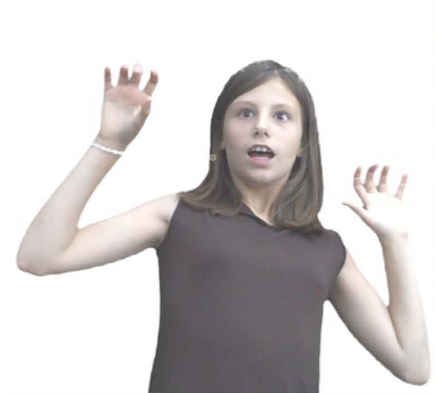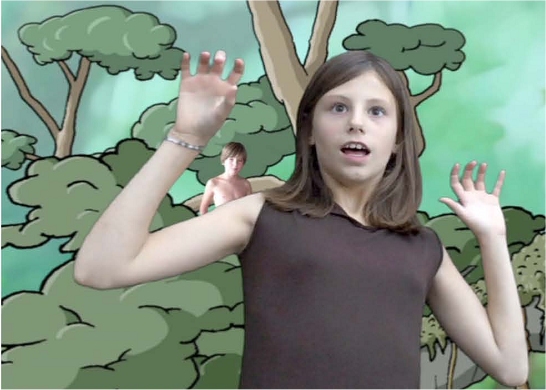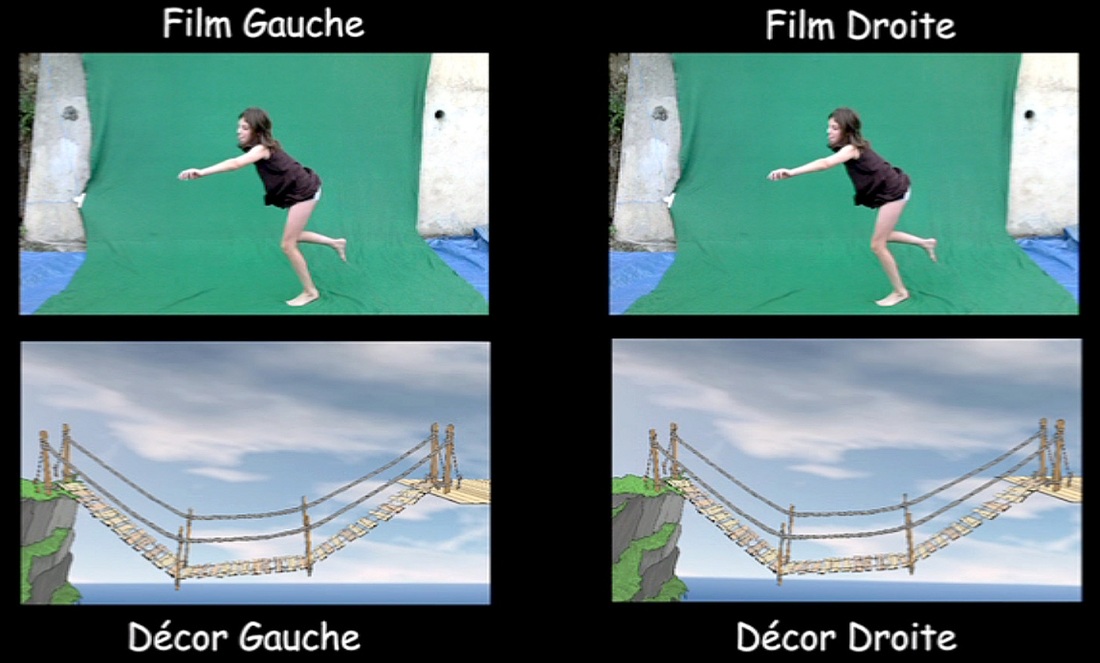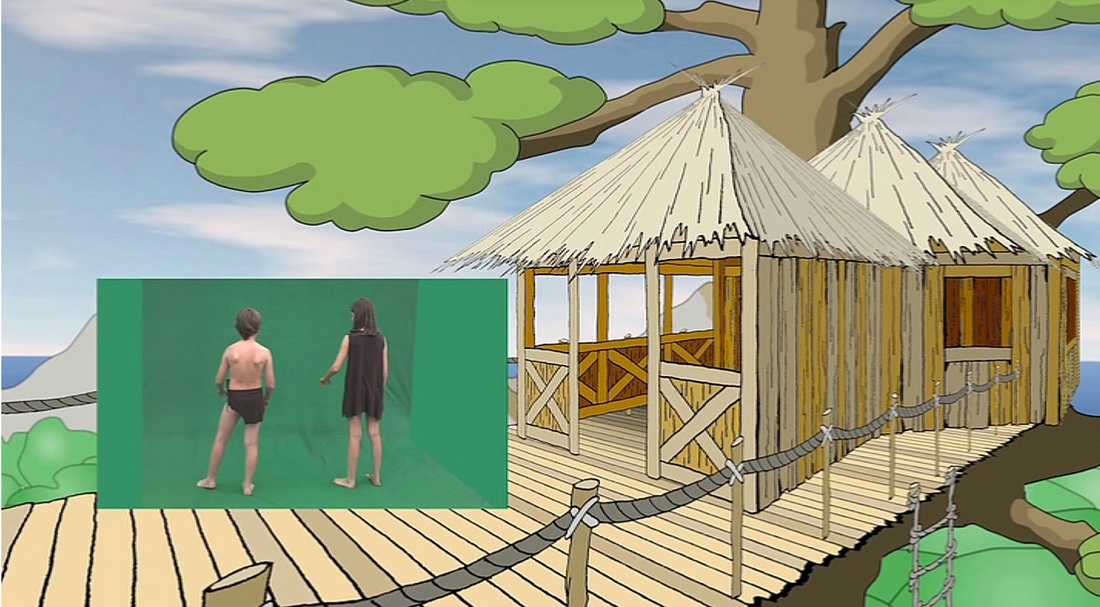LA CABANE - 2
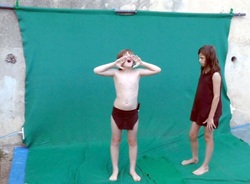
Shooting:
Two-thirds of the film's 67 scenes were shot outside in the Var region during the summer holidays. Every scene was made against a green screen, avoiding direct sunlight. The screen was put up and taken down twice a day for a whole week. The constraint imposed by the light reduced the chances for shooting to ten periods of an hour: 5 in the mornings and 5 in the evenings.
Live sound was impractical because I had to direct the actors, who were playing to nothing in an environment devoid of anything but a green screen. It was a bit like scenes in "Who Framed Roger Rabbit?"
For them it was their first acting opportunity. It was not easy. The swimming sequences originally planned for the green screen were eventually made in our swimming pool. The first takes had to be perfect because of wet clothes and hair. The problem was the transparency of the water and its blue appearance. The sequences were good, but we had to plan for retouching in the future thanks to conflicting details ... tiles, lights, the pool curbs ... and we had to change the water to green.
Two-thirds of the film's 67 scenes were shot outside in the Var region during the summer holidays. Every scene was made against a green screen, avoiding direct sunlight. The screen was put up and taken down twice a day for a whole week. The constraint imposed by the light reduced the chances for shooting to ten periods of an hour: 5 in the mornings and 5 in the evenings.
Live sound was impractical because I had to direct the actors, who were playing to nothing in an environment devoid of anything but a green screen. It was a bit like scenes in "Who Framed Roger Rabbit?"
For them it was their first acting opportunity. It was not easy. The swimming sequences originally planned for the green screen were eventually made in our swimming pool. The first takes had to be perfect because of wet clothes and hair. The problem was the transparency of the water and its blue appearance. The sequences were good, but we had to plan for retouching in the future thanks to conflicting details ... tiles, lights, the pool curbs ... and we had to change the water to green.
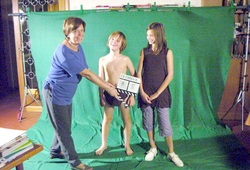
Lesquin (our home)
The remaining shots were filmed in our house in Lesquin. The cabin layout, the setting-off for school and a few other missing shots were taken against a green screen mounted in our living room.
The remaining shots were filmed in our house in Lesquin. The cabin layout, the setting-off for school and a few other missing shots were taken against a green screen mounted in our living room.
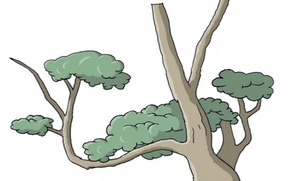
Graphics
All the details of the "sets" (about 300) were drawn separately in Indian ink, scanned and coloured in Photoshop. It was thus possible to compose sets in depth, element by element. The animated characters were drawn on my animation desk. Hundreds of drawings on paper were scanned and vectorised by hand, and coloured in the computer. (This has been the norm since the end of animation cels and gouache paints.)
The movements of the backgrounds had to match perfectly the movements of the actors ... with everything places at the correct depth. Everything was always done in duplicate for the left and the right image. The depth adjustment was based on the right image by shifting the element concerned left or right to move it apparently away or closer.
All the details of the "sets" (about 300) were drawn separately in Indian ink, scanned and coloured in Photoshop. It was thus possible to compose sets in depth, element by element. The animated characters were drawn on my animation desk. Hundreds of drawings on paper were scanned and vectorised by hand, and coloured in the computer. (This has been the norm since the end of animation cels and gouache paints.)
The movements of the backgrounds had to match perfectly the movements of the actors ... with everything places at the correct depth. Everything was always done in duplicate for the left and the right image. The depth adjustment was based on the right image by shifting the element concerned left or right to move it apparently away or closer.
|
Taking the actors out of the green screen:
The images of the actors, having been filmed (left and right) in front of the green screen, now had to be set in place against the drawn backgrounds and matched with the animations. In After Effects deep green was transformed into an alpha channel matte. If that was set to black, the area became transparent and when set to white is opaque. |
That is how the actors can appear to be on a transparent background, like drawn anime characters. It is in correctly separating the right image from the left that the elements move up or down in the composition. Sets, animations and actors are then placed in perspective.
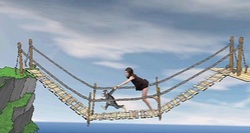
3D Technique:
For every plan ... there are problems which have to be resolved.
The final film is actually 4 films mixed together...
2 films for the actors: 1 for the right eye and 1 for the left eye...
2 films for the backgrounds and animations: 1 for the right eye and one for the left ...
The biggest problem is doing the compositing of actors, scenery and animation. It is essential to set all the elements precisely, in front of or behind the plane of the screen.
For every plan ... there are problems which have to be resolved.
The final film is actually 4 films mixed together...
2 films for the actors: 1 for the right eye and 1 for the left eye...
2 films for the backgrounds and animations: 1 for the right eye and one for the left ...
The biggest problem is doing the compositing of actors, scenery and animation. It is essential to set all the elements precisely, in front of or behind the plane of the screen.
Here are some examples
Exterior shot of the cabin:
Exterior shot of the cabin:
This scenery is really made up of flat elements placed in the space, like scenery in a theatre. The difficulty is always to match the background movement with the actors who were shot in a fixed frame. The actors had to be set at the correct depth despite the movements of the virtual 3D camera.
